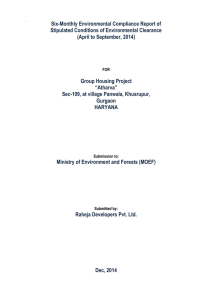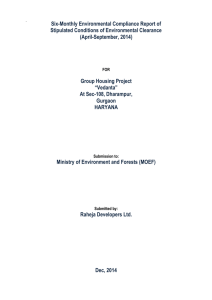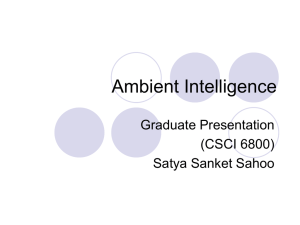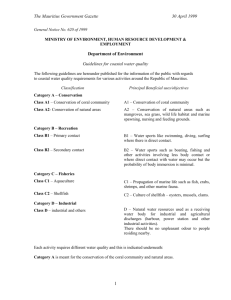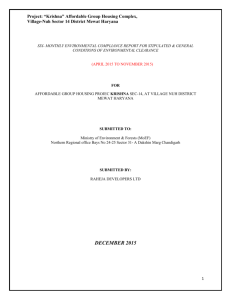part b – general conditions - Regional Office, Chandigarh
advertisement
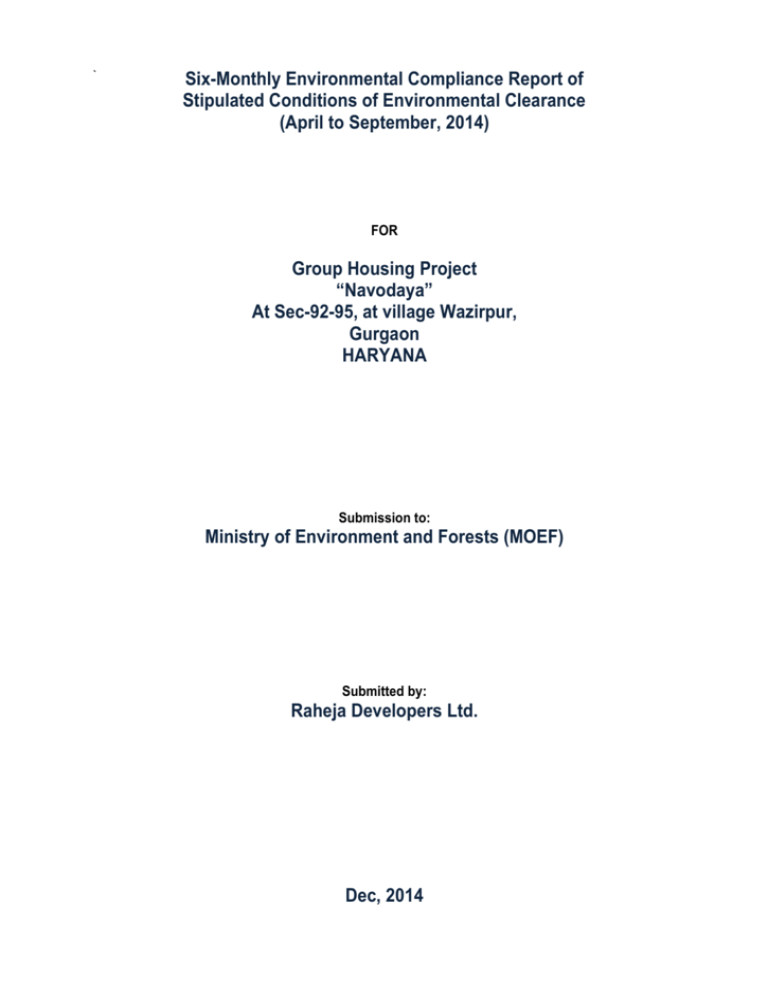
` Six-Monthly Environmental Compliance Report of Stipulated Conditions of Environmental Clearance (April to September, 2014) FOR Group Housing Project “Navodaya” At Sec-92-95, at village Wazirpur, Gurgaon HARYANA Submission to: Ministry of Environment and Forests (MOEF) Submitted by: Raheja Developers Ltd. Dec, 2014 Project: Group Housing Project “Nayodaya” at Sec-92-95, at village Wazirpur, Gurgaon. Haryana Half-yearly Compliance Report of EC Conditions Page 2 of 16 Contents Description Chapter 1 Introduction and Project Description 1.1 Introduction Page No. 1.2 1.3 1.4 Chapter 2 Part A Project Description Present Status Purpose of the Report Compliance of Stipulated Conditions of Environmental Clearance Specific Conditions for buildings in operational phase I. Construction Phase 4 4 4 Part B Chapter 3 3.1 3.1.1 3.1.2 3.1.3 II. Operation Phase General Conditions Details of Environmental Monitoring Ambient Air Quality Monitoring Ambient Air Quality Monitoring Stations Ambient Air Quality Monitoring Methodology Ambient Air Quality Monitoring Results 8 10 3.1.4 3.2 3.2.1 3.2.2 3.2.3 3.2.4 Discussion on Ambient Air Quality in the Study Area Ambient Noise Monitoring Ambient Noise Monitoring Locations Methodology of Noise Monitoring Ambient Noise Monitoring Results Discussion on Ambient Noise Levels in the Study Area 12 12 12 13 13 13 3.3 3.3.1 3.3.2 3.3.3 3.3.4 3.4 Groundwater Quality Monitoring Groundwater Quality Monitoring Locations Methodology of Groundwater Quality Monitoring Groundwater Quality Monitoring Results Discussion on Groundwater Quality in the Study Area Soil Monitoring 14 14 14 14 15 15 3.4.1 3.4.2 3.4.3 3.4.4 Tables 3.1 3.2 Soil Monitoring Locations Methodology of Soil Monitoring Soil Monitoring Results Discussion on Soil Characteristics in the Study Area 15 16 16 16 Details of Ambient Air Quality Monitoring Stations Techniques used for Ambient Air Quality Monitoring 11 11 3.3 3.4 3.5 3.6 3.7 3.8 Ambient Air Quality Monitoring Results Details of Ambient Noise Monitoring Stations Ambient Noise Monitoring Results Details of Water Quality Monitoring Station Groundwater Quality Monitoring Results Details of Soil Quality Monitoring Location 12 12 13 14 14 15 3.9 Figures 3.1 3.2 Annex Physico-Chemical Characteristics of Soil in the Study Area 16 Ambient Air Quality level Ambient Noise Levels 12 13 4 6 11 11 11 12 Project: Group Housing Project “Nayodaya” at Sec-92-95, at village Wazirpur, Gurgaon. Haryana Half-yearly Compliance Report of EC Conditions Page 3 of 16 Description 1 2 Environmental clearance letter Monitoring reports Page No. Project: Group Housing Project “Nayodaya” at Sec-92-95, at village Wazirpur, Gurgaon. Haryana Half-yearly Compliance Report of EC Conditions Page 4 of 16 Chapter 1 Introduction and Project Description 1.1 Introduction The Group Housing Complex is being developed in Village Wazirpur, Sector 92 & 95, Gurgaon Haryana, by Raheja Developers. Pvt. Ltd. to facilitate Residential services. This project has been awarded ‘Gold” grading by SEAC, Haryana. The project has been sanctioned by the Department of Town & Country Planning (DTCP), Govt. of Haryana. This project has been granted environmental clearance by the State Environmental Impact Assessment Authority, under category 8(a), Haryana vide reference number DEH/09/SEIAA/478 dated 26/05/2009. The total cost of the project is Rs. 24.5 crores. 1.2 Project Description Salient Features: This project involves construction of group housing on a plot area of 68796.45 sq.m. Total Builtup area is 174657.291 sq.m. The proposed building comprises of 2 blocks with a nursery school in each block. The height of the building is 60 M. The NOC from airport authority has already been obtained. The total fresh water requirement is 175 which will be supplied by municipality. The waste water generation will be about 129 KLD which will be treated in STP of 150 KLD capacity. The 95 KLD of treated water will be reused in horticulture, cooling of DG, flushing and washing and the excess water will be discharge into the public sewer with permission. Total solid waste generation will be 1745 Kg/day, which will be disposed off as per SWM & Handling Rules. Parking: The building project will have adequate parking facility with 1063 ECS in open/stilt area. Water Supply: The source of water supply is through Tankers of treated waste water during construction phase and during Operational phase water supply will be from the municipality. Electricity: The building will avail electricity from HVVN. The power requirement is approximately 5580 KW. 1.3 Present Status Project is in construction phase. 1.4 Purpose of the Report This six-monthly report is being submitted as per the condition stipulated in the Environmental Clearance letter. Further, the study will envisage the environmental impacts that have generated in the local environment due to the project. Project: Group Housing Project “Nayodaya” at Sec-92-95, at village Wazirpur, Gurgaon. Haryana Half-yearly Compliance Report of EC Conditions Page 5 of 16 The environmental assessment is being carried out to verify: That the project does not have any adverse environmental impacts in the project area and its surrounding Compliance with the conditions stipulated in the Environmental Clearance Letter. That the Project Management is implementing the environmental mitigation measures as suggested in the approved Form-1, Form-1A, Environmental Management Plan (EMP) and building plans. The project proponent is implementing the environmental safeguards in true spirit. Any non-conformity in the project with respect to the environmental implication of the project. Project: Group Housing Project “Nayodaya” at Sec-92-95, at village Wazirpur, Gurgaon. Haryana Half-yearly Compliance Report of EC Conditions Page 6 of 16 Chapter 2 Compliance of Stipulated Conditions of Environmental Clearance for Buildings in Operational Phase PART A – SPECIFIC CONDITIONS I. S. No. 1 2 3 4 5 6 7 8 Construction Phase Conditions of Environmental Clearance Status of Compliance A first aid room will be provided in the project both during construction and operation phase of the project. Adequate drinking water and sanitary facilities should be provided for construction workers at site. Provision should be made for mobile toilets. Open desiccation by the labours strictly prohibited. The safe disposal of waste water and solid wastes generated during the construction phase should be ensured. All the topsoil excavated during construction activities should be stored for use in horticulture/landscape development within the project site Disposal of muck during construction phase should not create any adverse effect on the neighboring communities and be disposed taking the necessary precautions for general safety and health aspects of people, only in approved sites with the approval of competent authority. Construction spoils, including bituminous material and other hazardous materials, must not be allowed to contaminate watercourses and the dump sites for such material must be secured so that they should not leach into the ground water and any hazardous waste generated during construction phase, should be disposed off as per applicable rules and norms with necessary approval of the Haryana State Pollution Control Board. The diesel generator sets to be used during construction phase should be of low sulphur diesel type and should conform to Environment (Protection) Rules prescribed for air and noise emission standards The diesel required for operating DG sets shall be stored in underground tanks and if required, clearance from Chief Controller of Explosives shall be taken. First aid facility is readily available at the project site in the custody of the project in charge Ambient noise levels should conform to residential standards both during day and night. Incremental pollution loads on the ambient air and noise quality should be closely monitored during construction Ambient noise level monitoring was carried out and it was found to be within the prescribed limit of residential standards during day and night. Incremental pollution loads on the ambient air and noise quality is closely monitored during Supply of drinking water and provision of sanitary facility has been provided within the project site. There is provision of mobile toilets for the construction workers and open desiccation is prohibited. The safe and proper disposal of solid waste is in practice. Top soil is stored at secured location and will be used for landscaping after completion of civil work. There is no larger quantity of muck generated during construction activity. Hazardous waste generated is being disposed as per HSPCB guideline. Construction spoils, including bituminous material and other hazardous materials is disposed off in scientific manner. There is no adverse impact on the watercourses. Low sulphur diesel is being used to run the DG sets during power failure and it confirms to Environment (Protection) Rules prescribed for air and noise emission standards. The diesel required for operating DG sets is stored/ secured in such a way that no accidents, spillage and leakage possible. Project: Group Housing Project “Nayodaya” at Sec-92-95, at village Wazirpur, Gurgaon. Haryana Half-yearly Compliance Report of EC Conditions Page 7 of 16 S. No. 9 10 11 12 13 14 15 16 17 Conditions of Environmental Clearance Status of Compliance phase. Adequate measures should be taken to reduce ambient air and noise level during construction phase, so as to conform to the stipulated standards Fly ash should be used as building material in the construction as per the provisions of Fly Ash Notification of September, 1999 and amended as on 27th August 2003 construction phase. Adequate measures have been taken to reduce ambient air and noise level during construction phase. Ready mix concrete must be used in building construction Storm water control and its re-use as per CGWB and BIS standards for various applications Water demand during construction should be reduced by use of pre-mixed concrete, curing agents and other best practices referred Permission from competent authority for supply of water shall be obtained prior to construction/ operation of the project Roof should meet prescribed requirement as per Energy Conservation Building Code by using appropriate thermal insulation materials to fulfill requirement Opaque wall should meet prescriptive requirement as per Energy Conservation Building Code which is proposed to be mandatory for all air conditioned spaces while it is aspirational for non-airconditioned spaces by use of appropriate thermal insulation material to fulfill requirement. The approval of the competent authority shall be obtained for structural safety of the building due to earthquake, adequacy of fire fighting equipments etc. as per National Building Code including protection measures from lighting etc. If any forest land is involved in the proposed site, clearance under forest Conservation Act shall be taken from the competent Authority During Construction phase the project proponent will use water brought to the site by tankers from safe area. In no case the ground water will be abstracted/developed except with the permission of the DC/CGWA. Fly ash is being used 15-20% in Ready Mix Concrete as building material in the construction as per the provisions of Fly Ash Notification of September, 1999 and amended as on 27th August 2003 Ready Mix Concrete is used for the project Storm water was controlled by laying proper internal drainage network within the project site Ready mix concrete is being used for construction to conserve and avoid wastage of water. Curing agents for quick settling of RCC is being used as recommended in the code. Assurance for Water supply has been obtained from HUDA for the operation phase This is residential non-central air-conditioned project However, mud phuska with white broken glazed china type flooring is proposed to reflect heat for reduction of cooling load and conserve energy. This is residential non-central air-conditioned project. Energy conservation measures would be adopted to the extent feasible. All approvals from the competent authority have been obtained for structural safety of the building due to earthquake, adequacy of fire fighting equipments etc. No forest land is involved. The project site is designated under residential land use; however NOC from forest department has been obtained. Demand of water supply for the construction phase is being met through treated water supply through tankers from nearest municipal STP; which is treated in onsite STP to make it fit for construction purpose. Project: Group Housing Project “Nayodaya” at Sec-92-95, at village Wazirpur, Gurgaon. Haryana Half-yearly Compliance Report of EC Conditions Page 8 of 16 II. Operation Phase The project is still under construction. S. No 1 2 3 4 5 6 7 8 Conditions of Environmental Clearance Status of Compliance The STP shall be installed for the treatment of the sewage generated to the prescribed standards including odour and treated effluent will be recycled to achieve zero discharge. The STP should be installed at the farthest place in the project area. Separation of gray and black water should be done by the use of dual plumbing line. Treatment of 100% gray water by decentralized treatment should be done ensuring that the recirculated water should have BOD maximum 10 pm and the recycled water will be used for flushing, gardening and HVAC makeup and DG set cooling. For disinfections of the treated wastewater ultra violate radiation or ozonization should be used. The solid waste generated should be properly collected and segregated. Wet garbage should be composted and dry/inert solid waste should be disposed off to the approved sires for land filling after recovering recyclable material. Will be complied. Diesel power generating sets proposed as source of backup power for lifts, common area illumination and for domestic use should be of enclosed type and conform to rules made under the Environment (Protection) Act, 1986. The location of the DF sets should be in the basement as promised by the project proponent with appropriate stack height as per the CPCB norms. The diesel used for DG sets should be of low sulphur contents (Maximum 0.25%). Ambient Noise level should be controlled to ensure that it does not exceed the prescribed standards both within and at the boundary of the proposed Residential project (Commercial Complex). DG sets installed would be of enclosed type conforming to the rules made under EP Act 1986. DG stack would go above building block. The height above building block would be as per CPCB norms. Low sulphur diesel (with maximum sulphur content of 0.25%) would be used for operating DG Sets. The project proponent should maintain at least 15% as green cover area for tree plantation especially all around the periphery of the project and on the road sides preferably with local species so as to provide protection against particulate and noise. The open spaces inside the plot should be preferably landscaped and covered with vegetation/grass. Weep holes in the compound walls shall be Landscape will be developed after completion of entire building works. There is provision of green belt development in the project area of green cover area for tree plantation especially all around the periphery of the project and on the road sides preferably with local species so as to provide protection against particulate and noise. Dual plumbing will be provided. Treated water will be used for flushing, gardening and D.G. cooling after testing. Will be complied Will be complied Ambient noise level at the project site during operation phase will be monitored and it will be ensured that the ambient noise level would not exceed the prescribed standards both within and at the boundary of the project site. There is provision of weep holes in the Project: Group Housing Project “Nayodaya” at Sec-92-95, at village Wazirpur, Gurgaon. Haryana Half-yearly Compliance Report of EC Conditions Page 9 of 16 9 10 11 12 13 14 15 16 provided to ensure natural drainage of rain water in the catchment area during the monsoon period compound walls for natural drainage of rain water in the catchment area during the monsoon period. Rain water harvesting for roof run-off and surface run-off as per plan submitted should be implemented. Before recharging the surface runoff, pre run off treatment must be done to remove suspended matter, oil and grease. The bore well for rain water recharging should be kept at least 5 m above the highest ground water table. Efforts will be made by the project proponent to utilize the water runoff during the construction phase for recharging by providing water harvesting system simultaneously. The ground water level and its quality should be monitored regularly in consultation with Central Ground Water Authority. There should be no traffic congestion near the entry and exit points for the road adjoining the proposed project site. Parking should be fully internalized and no public space should be utilized. A report on the energy conservation measures conforming to energy conservation norms finalize by Bureau of Energy Efficiency should be prepared incorporating details about building materials and technology, R & U Factors etc. and submit to the IA Division of Environment Department, Haryana in three months time Energy conservation measures like installation of CFLs/ TELs for lighting the areas outside the building should be integral part of the project design and should be in place before project commissioning. Used CFLs and TFLs should be properly collected and disposed off/ sent for recycling as per the prevailing guidelines/ rules of the regulatory authority to avoid mercury contamination. Use of solar panels should be done to maximum extent possible. The solid waste generated should be properly collected and segregated as per the requirement of the MSW Rules 2000. The provision of the solar water heating system shall be as per the norms specified by HAREDA and shall be made operational in each building block The project will be operationalized only after the permission obtained from CGWA for the abstractions of the water or after the compilation of infrastructure including supply of water by HUDA. Adequate number of RWH pits will be constructed in the operational part of the building. RWH pits have been designed as per CGWB norms. The ground water level and its quality would be monitored regularly in consultation with Central Ground Water Authority. It will be ensured that no traffic congestion take place. No public space will be utilized for parking during operation phase The report on the energy conservation measures conforming to energy conservation norms finalized by Bureau of Energy Efficiency will be prepared and the same will be submitted to the IA Division of Environment Department, Haryana Energy efficient luminaries like CFL would be used in common areas during the operational phase of the project. Solid waste are being collected by MCG authorized collector and disposed off securely at Municipal Waste Management Facility Solar water heating system will be provided after completion of civil construction works It is ensured that project will be operationalized only after the permission obtained from CGWA for the abstractions of the water or after the compilation of infrastructure including supply of water by HUDA. Project: Group Housing Project “Nayodaya” at Sec-92-95, at village Wazirpur, Gurgaon. Haryana Half-yearly Compliance Report of EC Conditions Page 10 of 16 PART B – GENERAL CONDITIONS S. No. I Conditions of Environmental Clearance Status of Compliance The environmental safeguards contained in the EIA/EMP report should be implemented in letter and spirit. Environmental Safeguards as prescribed by the ministry of environment and forests in the clearance document is being implemented in true spirit. III Six-monthly monitoring reports should be submitted to the HSPCB and Regional Office, MOEF, GOI, Northern Region, Chandigarh and a copy to the Regulatory Authority of Haryana. Six monthly environmental compliance reports has been prepared and is being submitted to the HSPCB and Regional office, MOEF, GOI, Northern Region, Chandigarh. III The project proponent will sent one copy of the EMP report to Additional Director, Regional Office, MOEF, GOI, Sector 31, Chandigarh and to the Chairman, Haryana State Pollution Control Board for their reference. Same has been submitted along with EIA report. IV The SEIAA, Haryana reserves the right to add additional safeguard measures subsequently, if found necessary. Environment Clearance granted will be revoked if it is found that false information has been given for getting approval of this project. The project will accept any suggestion by the SEIAA for environmental safeguard. V All other statutory clearances such as the approvals for storage of diesel from Chief Controller of Explosives, Fire Department, Civil Aviation Department, Forest Conservation Act, 1980 and Wildlife (Protection) Act, 1972, shall be obtained, as applicable by project proponents from the respective authorities. All other statutory clearances required for the project will be obtained from the concerned authorities. However, NOC from AAI has been obtained, attached as annexure:3 VI These stipulations would be enforced among others under the provisions of Water (Prevention and Control) Act, 1981, the Environmental Protection Act 1986, The Public Liability (Insurance) Act, 1991 and EIA Notification, 2006. Same will be complied. VIII The project proponent will not violate any judicial orders/ pronouncement issued by the Hon’ble Supreme Court/High Courts. It is ensured that project proponent will abide any judicial orders/ pronouncement issued by the Hon’ble Supreme/High Courts Project: Group Housing Project “Nayodaya” at Sec-92-95, at village Wazirpur, Gurgaon. Haryana Half-yearly Compliance Report of EC Conditions Page 11 of 16 Chapter 3 Details of Environmental Monitoring 3.1 AMBIENT AIR QUALITY MONITORING 3.1.1 Ambient Air Quality Monitoring Stations Ambient air quality monitoring has been carried out at one location, one being in nearby the main gate to assess the ambient air quality. This will enable to have an analytical understanding about air quality and the changes in the air environment in the study area with respect to the condition prevailing. The locations of the ambient air quality monitoring stations are given in Table 3.1. Table 3.1 Details of Ambient Air Quality Monitoring Station S. Locn. No. Code 1. AAQ-1 3.1.2 Location Name/ Description Environmental Setting Near the main gate of project site Residential Ambient Air Quality Monitoring Methodology Monitoring was conducted in respect of the following parameters: Particulate Matter 2.5 (PM 2.5) Particulate Matter 10 (PM 10) Sulphur Dioxide (SO2) Oxides of Nitrogen (NO x) Carbon Monoxide (CO) The duration of sampling of PM2.5, PM10, SO2 and NOx was 24 hourly continuous sampling per day and CO was sampled for 8 hours continuous, thrice in 24 hour duration monitoring. The monitoring was conducted for one day at the location. This is to allow a comparison with the National Ambient Air Quality Standards. The air samples were analyzed as per standard methods specified by Central Pollution Control Board (CPCB) and IS: 5182.The techniques used for ambient air quality monitoring and minimum detectable levels are given in Table 3.2. Fine Particulate Sampler APM 550 instruments have been used for monitoring Particulate Matter 2.5 (PM2.5 i.e. <2.5 microns), and Respirable Dust Sampler APM 450 was used for sampling Respirable fraction (<10 microns), gaseous pollutants like SO2, and NOx. Bladder and Aspirator bags were used for collection Carbon monoxide samples. Gas Chromatography techniques have been used for the estimation of CO. Table 3.2 Techniques used for Ambient Air Quality Monitoring S. Parameter No. 1 Particulate Matter 2.5 2 3 4 5 Technique Fine Particulate Sampler APM 550, Gravimetric Method Particulate Matter 10 Respirable Dust Sampler APM 450, with cyclone separator, Gravimetric Method Sulphur dioxide Modified West and Gaeke Oxides of Nitrogen Jacob & Hochheiser Carbon Monoxide Gas Chromatography Technical Protocol IS-5182 (Part-IV) IS-5182 (Part-23) IS-5182 (Part- II) IS-5182 (Part-VI) IS-5182 (Part-X) Project: Group Housing Project “Nayodaya” at Sec-92-95, at village Wazirpur, Gurgaon. Haryana Half-yearly Compliance Report of EC Conditions Page 12 of 16 3.1.3 Ambient Air Quality Monitoring Results The detailed on-site monitoring results of PM 2.5, PM 10, SO2, NOx and CO are presented in Table 3.3. Table 3.3 Ambient Air Quality Monitoring Results S. Locn. No. Code 1. 3.1.4 Location PM10 PM2.5 (g/m3) (g/m3) 100 60 Limit AAQ-1 Nearby the main gate of project site 153 62.8 SO2 (g/m3) 80 NOx (g/m3) 80 CO (mg/m3) 2.0 19 47 1.10 Discussion on Ambient Air Quality in the Study Area PM10 and PM2.5 levels at the main gate project site above the permissible limit of 100 μg/m3and 60 μg/m3respectively (for residential, rural and other areas as stipulated in the National Ambient Air Quality Standards). SO2, NOx and CO was observed within the corresponding stipulated limits (Limit for SO2 and NOx: 80 g/m3 and limit for CO: 2.0mg/m3) at all monitoring locations. variation of ambient air quality parameters has been pictorially shown in Figure 1 160 140 120 100 80 Code Limit 60 40 AAQ-1 Nearby the main gate of project site 20 (ug/m3) (ug/m3) (ug/m3) (ug/m3) (mg/m3) 0 PM10 PM2.5 SO2 NOx CO Figure 3.1 Variation of Ambient Air Quality 3.2 AMBIENT NOISE MONITORING 3.2.1 Ambiant Noise Monitoring Locations The main objective of noise monitoring in the study area is to assess the present ambient noise levels in project site & project boundary due to various construction allied activities and increased vehicular movement. A preliminary reconnaissance survey has been undertaken to identify the major noise generating sources in the area. Ambient noise monitoring was conducted at 2 locations at the boundary of the project site as given in Table 3.4. Table 3.4 Details of Ambient Noise Monitoring Stations S. No. 1. 2. Locn. Code N1 N2 Location Name/ Description Near main gate Back side of the building Present Landuse Residential Residential Project: Group Housing Project “Nayodaya” at Sec-92-95, at village Wazirpur, Gurgaon. Haryana Half-yearly Compliance Report of EC Conditions Page 13 of 16 3.2.2 Methodology of Noise Monitoring Noise levels were measured using integrated sound level meter manufactured by Quest Technologies. The integrating sound level meter is an integrating/ logging type with Octave filter attachment with frequency range of 31.5 to 16000 Hz. This instrument is capable of measuring the Sound Pressure Level (SPL), Leq and octave band frequency analysis. Noise level monitoring was carried out continuously for 24-hours with one hour interval starting at 0030 hrs to 0030 hrs next day. The noise levels were monitored on working days only. During each hour Leq were directly computed by the instrument based on the sound pressure levels. Lday (Ld), Lnight (Ln) and Ldn values were computed using corresponding hourly Leq. Monitoring was carried out at ‘A’ response and fast mode. 3.2.3 Ambient Noise Monitoring Results The time wise ambient noise monitoring results is summarized in Table 3.5. The time-wise variation of noise levels are graphically presented in Figure 3.2. Table 3.5 Ambient Noise Monitoring Results Sr. No. D-1 D-2 Day Time - dB(A) Limits as per Results CPCB guideline 54.3 55 50.1 Test Locations Near Main Gate Back Side of the building Night Time - dB(A) Results Limits as per CPCB guideline 41.2 43.1 45 60 50 40 30 Near Main Gate 20 Back Side of the building 10 0 Results Limits as per CPCB guideline Day Time - dB(A) Results Limits as per CPCB guideline Night Time - dB(A) Figure 3.2 Location wise variation of Ambient Noise Level 3.2.4. Discussion on Ambient Noise Levels in the Study Area Day Time Noise Levels (Lday): The day time noise level at all the locations were found within the limits prescribed for Residential area i.e. 55 db(A). Night Time Noise Levels (Lnight): The night time noise level at all the locations were within the limit prescribed for Residential area i.e. 45 dB (A). Project: Group Housing Project “Nayodaya” at Sec-92-95, at village Wazirpur, Gurgaon. Haryana Half-yearly Compliance Report of EC Conditions Page 14 of 16 3.3 GROUNDWATER QUALITY MONITORING 3.3.1 Groundwater Quality Monitoring Locations Keeping in view the importance of groundwater as an important source of drinking water to the local population, sample of ground water was collected from the project site for the assessment of impacts of the project on the groundwater quality. Water sample was collected from one location near the project site. The sample was analyzed for various parameters to compare with the standards for drinking water as per IS: 10500 for ground water sources. The details of water sampling locations are given in Table 3.6. Table 3.6 Details of Water Quality Monitoring Station S. No. 1. 3.3.2 Locn. Code Location Name/ Description GW1 Near the project site Methodology of Groundwater Quality Monitoring Sampling of ground water was carried out on September 2014. Samples were collected as grab sample and sampling forms are filled in as per the sampling plan. The preservative sample were properly added to preserve as per standard operating procedures (SOP) and stored immediately in ice boxes, which were ensured for appropriate temperatures. Sample for chemical analysis was collected in polyethylene carboys. Sample collected for metal content were acidified to <2 pH with 1 ml HNO3. A sample for bacteriological analysis was collected in sterilized glass bottles. Soon after the completion of sampling, chain of custody sheets for the samples are filled in and then they were transported by road to ITL Labs Pvt. Ltd., Delhi for further analysis. Proper care was taken during packing and transportation of samples. All the samples reached the central laboratory within the holding times for different parameters. After ensuring the same the samples were forwarded immediately for analysis. The samples were analyzed as per the standard procedures specified in 'Standard Methods for the Examination of Water and Wastewater' published by American Public Health Association (APHA) and CPCB. The analytical techniques and the test methods adopted for testing of ground water are given in Table 3.7. 3.3.3 Groundwater Quality Monitoring Results The detailed groundwater quality monitoring results are presented in Table 3.7. Table 3.7 Groundwater Quality Monitoring Results S. No. Parameter Unit Results Protocol Drinking Water Specification (IS: 10500:1991) Desirable Limit Permissible Limit 5 Hazen Unit Unobjectionable Agreeable 1 15 Hazen Unit --5 Organoleptic and Physical Parameters 1. 2. 3. 4. Colour Odour pH Turbidity ---NTU 5. Total Dissolved solids mg/l 430 IS 3025 Part 16 / APHA 21ST ED., 3112 500 2000 Desirable Characteristics in Drinking Water 6 Total Hardness as CaCO3 mg/l 35 IS 3025(Part 21) 200 600 mg/l mg/ l 5 6 IS: 3025(PART-40) IS 3025 Part 46 75 30 200 100 mg/l 316 IS 3025(Part 23) 200 600 7 8 9 Calcium as Ca Magnesium as Mg Total Alkalinity as Calcium Carbonate 2 Agreeable 2.06 7.7 IS: 3025(PART-4)-2002 IS: 3025(PART-5)-2002 IS: 3025(PART-10)-2012 Project: Group Housing Project “Nayodaya” at Sec-92-95, at village Wazirpur, Gurgaon. Haryana Half-yearly Compliance Report of EC Conditions Page 15 of 16 10 11 12 13 14 15 16 17 18 19 20 21 22 Chloride as Cl mg/l Sulphate as SO4 mg/l Iron as Fe mg/l Fluoride as F mg/l Copper as Cu mg/l Free Residual Chlorine mg/l Nitrate as NO 3 mg/ l Sulphide as H2S mg/l Barium (as Ba) mg/l Mangnese as Mn mg/ l Mineral Oil mg/ l Boron mg/l Phenolic mg/l Compound(C6H5OH) 23 Zinc as Zn mg/l 24 Aluminium mg/l 25 Ammonia (as Total mg/l Ammonia-N) 26 Anioinic Detergents (as mg/l MBAS) Parameters Concerning Toxic Substances 27 Cadmium as Cd mg/l 28 Lead as Pb mg/l 29 Nickel as Ni mg/l 30 Arsenic (As) mg/l 50 .. 0.018 0.63 .. ND 6.3 ND ND 0.06 ND ND ND IS: 3025(PART-32)-2003 IS 3025(Part 24) IS 3025 Part 53 IS 3025 Part 60 IS 3025 Part 42 IS 3025 Part 26 IS 3025 Part 34 IS 3025(Part 29) IS 13428 or IS 15302 IS 3025 Part 59 IS 3025 Part 39 IS 3025 Part 57 IS: 3025(PART-43) 4.2 0.0086 0.036 IS 3025(Part 49) IS 3025(Part 55) IS 3025(Part 34) ND Annex K of IS 13428 ND 0.046 ND ND IS 3025(Part 41) IS 3025(Part 47) IS 3025(Part 54) IS 3025(Part 54) 250 200 0.3 1.0 0.05 0.2 45 0.05 0.7 0.1 0.5 0.5 1000 400 No relaxation 1.5 0.05 1.0 No Relaxation No Relaxation No Relaxation 0.3 No relaxation 1.0 0.001 0.002 5 0.03 15 0.2 0.5 No relaxation 0.2 1.0 0.003 0.01 0.02 0.05 No Relaxation No Relaxation No Relaxation 0.05 * BDL: below detection limit: detection limit 3.3.4 Discussion on Groundwater Quality in the Study Area The ground water quality in the project area is observed to having total alkalinity up to 316 which is higher than desirable limit of 200 mg/L. Total dissolved solids in the ground water is 430 mg/L which is within the prescribed limit of 500 mg/L. 3.4 SOIL MONITORING 3.4.1 Soil Monitoring Locations The objective of the soil monitoring is to identify the impacts of ongoing project activities on soil quality and also predict impacts, which have arisen due to execution of various constructions allied activities. Accordingly, a study of assessment of the soil quality has been carried out. To assess impacts of ongoing project activities on the soil in the area, the physico-chemical characteristics of soils were examined by obtaining soil samples from selected points and analysis of the same. One sample of soil was collected from the project site for studying soil characteristics, the location of which is listed in Table 3.8. Table 3.8 Details of Soil Quality Monitoring Location S. No. 1. \ 3.4.2 Locn. Code S1 Location Name/ Description Near the project site Methodology of Soil Monitoring The sampling has been done in line with IS: 2720 & Methods of Soil Analysis, Part-1, 2nd edition, 1986 of American Society for Agronomy and Soil Science Society of America. The homogenized samples were analyzed for physical and chemical characteristics (physical, chemical and heavy metal concentrations). The soil samples were collected in the month of May 2014. Project: Group Housing Project “Nayodaya” at Sec-92-95, at village Wazirpur, Gurgaon. Haryana Half-yearly Compliance Report of EC Conditions Page 16 of 16 The samples have been analyzed as per the established scientific methods for physico-chemical parameters. The heavy metals have been analyzed by using Atomic Absorption Spectrophotometer and Inductive Coupled Plasma Analyzer. 3.4.3 Soil Monitoring Results The physico-chemical characteristics of the soil, as obtained from the analysis of the soil sample, are presented in Table 3.9. Table 3.9 Physico-Chemical Characteristics of Soil in the Study Area S. No 3.4.4 1. Parameter pH Unit - Results 2. Conductivity mS 1.5 3. Moisture Content % 4.5 4. Total Alkalinity mg/kg 107 5. Water Holding capacity mg/kg 51 6. Phosphorous as P % <0.37 7. Porosity % 48 8. Zinc as Zn mg/Kg 0.73 9. Iron as Fe mg/Kg 0.56 10. 11. Chloride as Cl Sodium as Na mg/100gm meq/100gm 10.0 12. Potassium as K meq/100gm 6.5 13. Nitrogen as N mg/kg 17 14. Bulk Density g/cm3 1.29 15. Organic Content % 0.86 16. Cation Exchange Capacity meq/100gm 17. Heavy metals 8.4 56 12 Lead(Pb) mg/kg 0.83 Copper(Cu) mg/kg 1.39 18. calcium mg/100gm 13.20 19. Magnesium mg/100gm 1.15 Discussion on Soil Characteristics in the Study Area The soil in study area is characterized by neutral in nature. The soil quality in the project area has not been affected by the project activities.

